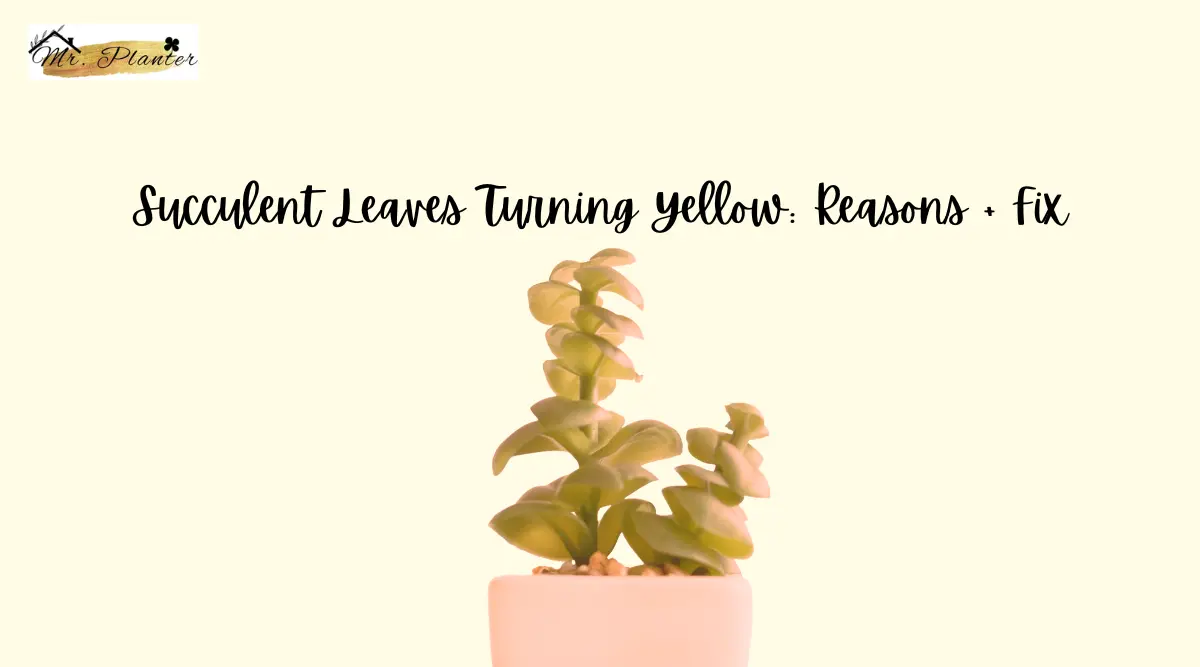If you’ve seen your succulent leaves turning yellow, you’re not alone – it’s a common issue many succulent owners encounter.
Within this guide, we will explore the most common reasons and provide solutions to fix this issue.

Reasons for Succulent Leaves Turning Yellow
Overwatering causes yellow leaves from root rot and nutrient deficiencies, underwatering leads to shedding older yellow leaves, pest damage causes spots and leaf drop, too much direct sunlight burns leaves yellowish-brown, and poor drainage induces root rot and prevents water uptake.
Here are the reasons in detail:
Overwatering
Overwatering is a common mistake that causes waterlogged soil and suffocates the roots, preventing oxygen intake.
This leads to root rot, where roots decay and cannot absorb nutrients properly. As a result, the leaves start turning yellow and might eventually fall off.
Underwatering
While succulents are drought-resistant, they still need some regular watering to stay healthy. Underwatering happens when the plant does not get sufficient water for a prolonged time.
This causes the succulent to conserve energy and resources by shedding its older, lower leaves first. The lack of water makes the leaves lose chlorophyll and turn yellow before falling off.
Pest Infestation
Pests like mealybugs, aphids, and spider mites commonly attack succulents and damage their leaves while feeding on sap.
They leave behind yellow spots or a yellow halo on leaves as they feed. A major infestation can spread quickly, stunt growth, and result in leaf drop.
Common signs of pests are tiny white blobs, sticky residue, or webbing on plants.
Too Much Direct Sunlight
While succulents love sunlight, too much exposure can actually burn the leaves, especially in summer. Intense, direct sunlight causes the leaves to turn yellowish-brown.
The plant may also appear stressed – wilted or droopy. This is sunburn, where damaged cells cannot produce green pigment.
Drainage Issues
Proper drainage is very important to prevent sitting water around roots.
Succulents planted in dense soil or pots without drainage holes will suffer from root rot due to lack of oxygen. Rotting roots are unable to uptake water.
How to Fix Succulent Leaves Turning Yellow?
To fix succulent leaves turning yellow, one should treat any pests, change the soil, dry out soaked roots, adjust the lighting, and establish a proper watering schedule tailored to the local climate.
Let’s discuss the ways in more detail:
Treat Pest Infestation
If you suspect a pest infestation, scrutinize your Succulent.
Here is the way to combat a pest infestation on your Succulent:
Carefully inspect your Succulent regularly. Take immediate action if you notice any signs of pests, such as webbing or sticky residue on the leaves.
Isolate the affected plant to prevent the pests from spreading to other succulents.
Remove the pests manually using a cotton swab dipped in rubbing alcohol or neem oil.
For a more extensive infestation, use an insecticidal soap or neem oil spray, following the product instructions diligently.
Change Soil
If your Succulent leaves are turning yellow due to overwatering or poor drainage, repotting the plant in well-draining soil can make a significant difference.
Use a specialized succulent or cactus mix that drains excess water from the roots.
Dry the Roots
It is crucial to dry out the roots of succulents suffering from overwatering. Carefully remove the plant from its pot and gently shake off excess soil.
Let the plant air-dry for a few hours before repotting it into dry soil. Avoid watering the Succulent for a few days to allow the roots to recover.
Fix the Lighting Condition
If your succulent shows sunburn, move it to a spot with bright, indirect sunlight. This would help the succulent to recover.
Fix the Watering Schedule
Establishing a proper watering schedule is essential for the health of your Succulent.
Water only when the top inch of the soil is dry, and adjust the frequency based on the climate and humidity in your location.
Frequently Asked Questions
How do you fix a yellowing succulent?
To fix the Yellowing Succulent issue, you can adjust the watering schedule and move the plant to a location with indirect sunlight. Additionally, you may want to check the soil for drainage issues and repot the plant if necessary.
Should I remove yellow leaves from succulents?
Yes, you should remove yellow leaves from succulents as they indicate that the plant is stressed or dying, and removing them can promote healthier growth.
What does it mean if succulent leaves turn yellow?
When succulent leaves turn yellow, it could indicate overwatering, underwatering, pests, nutrient deficiencies, or lack of sunlight.
Can yellow succulent leaves recover?
Yellow succulent leaves can recover depending on the extent of damage and care given. Early detection and appropriate measures can help the plant recover. Trim away severely damaged leaves to redirect the plant’s energy for healthy growth.
Can Yellow Leaves on Succulents be a Sign of Dying?
Yellow leaves on succulents can be one of the reasons for succulent dying. These vibrant plants typically thrive in bright sunlight and well-draining soil, but overwatering or inadequate light can cause stress, leading to yellowing leaves.
It is essential to adapt watering routines and ensure optimal sunlight exposure to prevent succulent decline.

